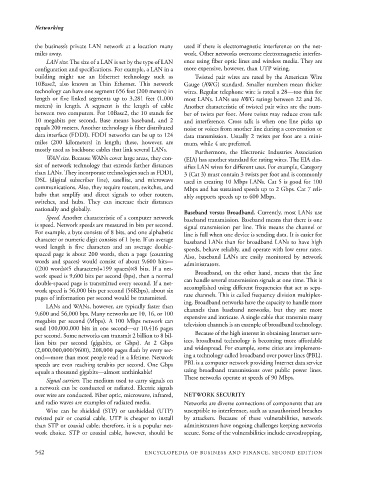Page 565 - Encyclopedia of Business and Finance
P. 565
eobf_N 7/5/06 3:16 PM Page 542
Networking
the business’s private LAN network at a location many used if there is electromagnetic interference on the net-
miles away. work. Other networks overcome electromagnetic interfer-
LAN size. The size of a LAN is set by the type of LAN ence using fiber optic lines and wireless media. They are
configuration and specifications. For example, a LAN in a more expensive, however, than UTP wiring.
building might use an Ethernet technology such as Twisted pair wires are rated by the American Wire
10Base2, also known as Thin Ethernet. This network Gauge (AWG) standard. Smaller numbers mean thicker
technology can have one segment 656 feet (200 meters) in wires. Regular telephone wire is rated a 28—too thin for
length or five linked segments up to 3,281 feet (1,000 most LANs. LANs use AWG ratings between 22 and 26.
meters) in length. A segment is the length of cable Another characteristic of twisted pair wires are the num-
between two computers. For 10Base2, the 10 stands for ber of twists per foot. More twists may reduce cross talk
10 megabits per second, Base means baseband, and 2 and interference. Cross talk is when one line picks up
equals 200 meters. Another technology is fiber distributed noise or voices from another line during a conversation or
data interface (FDDI). FDDI networks can be up to 124 data transmission. Usually 2 twists per foot are a mini-
miles (200 kilometers) in length; these, however, are mum, while 4 are preferred.
mostly used as backbone cables that link several LANs.
Furthermore, the Electronic Industries Association
WAN size. Because WANs cover large areas, they con- (EIA) has another standard for rating wires. The EIA clas-
sist of network technology that extends farther distances sifies LAN wires for different uses. For example, Category
than LANs. They incorporate technologies such as FDDI, 3 (Cat 3) must contain 3 twists per foot and is commonly
DSL (digital subscriber line), satellite, and microwave used in creating 10 Mbps LANs. Cat 5 is good for 100
communications. Also, they require routers, switches, and Mbps and has sustained speeds up to 2 Gbps. Cat 7 reli-
hubs that amplify and direct signals to other routers, ably supports speeds up to 600 Mbps.
switches, and hubs. They can increase their distances
nationally and globally.
Baseband versus Broadband. Currently, most LANs use
Speed. Another characteristic of a computer network baseband transmission. Baseband means that there is one
is speed. Network speeds are measured in bits per second.
signal transmission per line. This means the channel or
For example, a byte consists of 8 bits, and one alphabetic
line is full when one device is sending data. It is easier for
character or numeric digit consists of 1 byte. If an average
baseband LANs than for broadband LANs to have high
word length is five characters and an average double- speeds, behave reliably, and operate with low error rates.
spaced page is about 200 words, then a page (counting Also, baseband LANs are easily monitored by network
words and spaces) would consist of about 9,600 bits—
administrators.
((200 words¥5 characters)+199 spaces)¥8 bits. If a net-
Broadband, on the other hand, means that the line
work speed is 9,600 bits per second (bps), then a normal
can handle several transmission signals at one time. This is
double-spaced page is transmitted every second. If a net-
work speed is 56,000 bits per second (56Kbps), about six accomplished using different frequencies that act as sepa-
pages of information per second would be transmitted. rate channels. This is called frequency division multiplex-
ing. Broadband networks have the capacity to handle more
LANs and WANs, however, are typically faster than
9,600 and 56,000 bps. Many networks are 10, 16, or 100 channels than baseband networks, but they are more
expensive and intricate. A single cable that transmits many
megabits per second (Mbps). A 100 Mbps network can television channels is an example of broadband technology.
send 100,000,000 bits in one second—or 10,416 pages
per second. Some networks can transmit 2 billion to 8 bil- Because of the high interest in obtaining Internet serv-
lion bits per second (gigabits, or Gbps). At 2 Gbps ices, broadband technology is becoming more affordable
(2,000,000,000/9600), 208,000 pages flash by every sec- and widespread. For example, some cities are implement-
ond—more than most people read in a lifetime. Network ing a technology called broadband over power lines (PBL).
speeds are even reaching terabits per second. One Gbps PBL is a computer network providing Internet data service
equals a thousand gigabits—almost unthinkable! using broadband transmissions over public power lines.
These networks operate at speeds of 90 Mbps.
Signal carriers. The medium used to carry signals on
a network can be conducted or radiated. Electric signals
over wire are conducted. Fiber optic, microwave, infrared, NETWORK SECURITY
and radio waves are examples of radiated media. Networks are diverse connections of components that are
Wire can be shielded (STP) or unshielded (UTP) susceptible to interference, such as unauthorized breaches
twisted pair or coaxial cable. UTP is cheaper to install by attackers. Because of these vulnerabilities, network
than STP or coaxial cable; therefore, it is a popular net- administrators have ongoing challenges keeping networks
work choice. STP or coaxial cable, however, should be secure. Some of the vulnerabilities include eavesdropping,
542 ENCYCLOPEDIA OF BUSINESS AND FINANCE, SECOND EDITION

